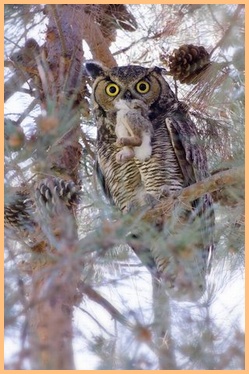| ORANGE COUNTY TRACKERS |
COPYRIGHT 2016 DICK NEWELL
| Living with Coyotes in Orange County |
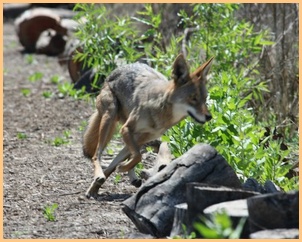
To some of us the thought of a coyote running through our neighborhoods is threatening while to others, seeing a wild animal living within our urban cities is refreshing. The coyote has always been here and it’s a survivor but what precautions should we be taking?
Make no mistake, a coyote is a wild animal and should be treated as such but there is little reason for undue concern. For coyotes as for all wild animals their very existence is all
Make no mistake, a coyote is a wild animal and should be treated as such but there is little reason for undue concern. For coyotes as for all wild animals their very existence is all
about finding that next meal and unlike humans who have facilities to store food, they must go on the hunt for each meal they consume. As a tracker I teach my students to follow the food trail if they want to find the animal. In the case of bobcats that food is usually a rabbit, squirrel or some other small rodent or bird that happens to appear in close proximity and at a time when the animal is hungry. Felines such as bobcats are obligate carnivores and will not consume any non meat items but neither are they particularly interested in our pets and local research on interaction of the two tends to support that.
Coyotes on the other hand are omnivores meaning that they can and will eat most anything that is available when they get hungry. This might include nuts, berries, plants or any meat source such as a rabbit, squirrel or bird and this could include your small pet if the opportunity is present and there is nothing to prevent the attack. Coyotes primarily use their sense of smell to locate their next meal but they quickly learn to return to those locations where they have found food or been fed previously. When a coyote seeks food in the wild it will walk around the perimeter of a large patch of shrubbery sniffing to determine if there might be a rabbit or some other critter hiding within the bushes.
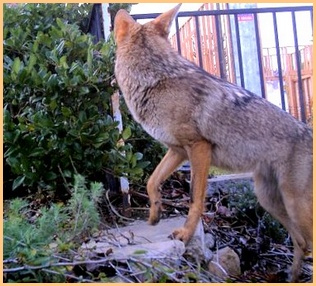
They have also learned that where man lives there is likely other food sources such as our rubbish, pet food or perhaps fruits that have fallen from the trees in our yards. The coyote is smart and tenacious and will constantly return to those communities that make food so easily available. If no food scents are readily detected in a particular neighborhood the animal may still return a few times until it finds a more reliable resource and this is where we can help ourselves and help keep the wild animals healthy.
Since coyotes are native animals there is little that will or should be done by governmental agencies but there is a great deal that we as responsible home owners can and should be doing.
Here are some suggestions: Start by removing all food sources such as bowls of pet food and don’t overlook the bird seed dispensers. These seem like a harmless thing to have in the yard but the coyote can smell the bird food and will even consume those seeds that drop to the ground but more importantly, squirrels, rats and mice will eat the seeds and then the coyote will smell the rodents and hang around your yard waiting a mouse dinner. You should also eliminate the water dishes that are left around the yard as these are another attractant for the coyotes as well as for skunks, raccoons, opossums, etc. None of these animals are necessarily undesirable as they will all help to get rid of the slugs, snails and mice that are in your yard but you might not want to have them around either.
If coyotes are coming in close proximity to humans it is because there is natural food available there or because someone has been feeding them in the past. Maybe it’s you or perhaps one of your “animal loving” neighbors have been surreptitiously leaving a little treat outside the door. You should never feed a wild animal as they will only continue to come back more often and will become more aggressive in future contacts and that is not in the best interest of anyone, including the animals. Trash containers need to be kept tightly closed. Strongly consider feeding your pets inside the house and your cats will be healthier and less likely to contract contagious diseases such as feline herpes virus if they are kept inside at all times. If you have a small dog you need to keep it close to you and never allow it to go outside alone at night as they can become a food source for a hungry coyote and, a large domestic dog is seen by the coyote as a threat to its territory and they will try to remove it any way they can.
Another predator upon our small pets that most people don’t even think about is the Great Horned Owl. With its 5' wingspan it can swoop down out of the night sky ever so silently and pick up and carry away a small pet. Since it leaves little evidence the loss of the pet is usually blamed on the coyote. Animal control officers or experienced trackers finding the remains will have no trouble determining the suspect but by then it is too late. We want to protect our pets before this happens and by following the above suggestions your neighborhood will become safer for all.
 |
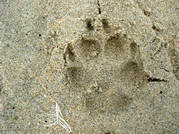
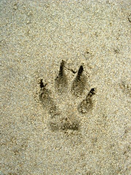

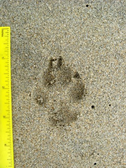
Can you correctly identify the track of the coyote?
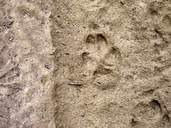
CLICK HERE FOR THE CORRECT ANSWER
California Department of Fish & Game offers information on controlling coyotes at http://www.dfg.ca.gov/keepmewild/coyote.html
 |
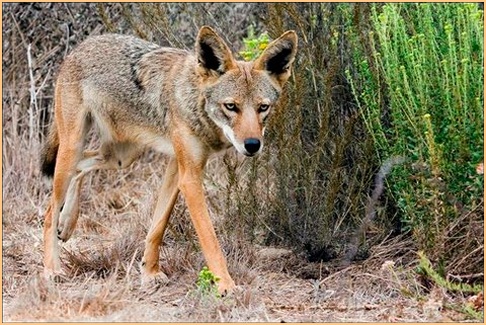
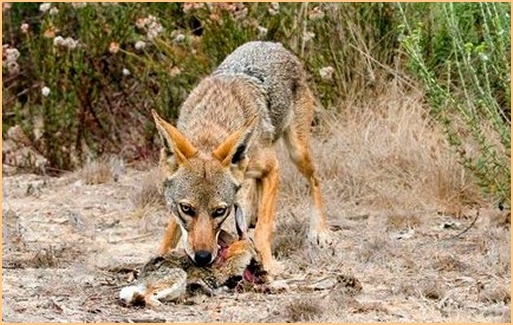
The above two coyote photos were taken by wildlife photographer Steve Shinn
Remember that capturing or killing coyotes is like cutting the lawn; it merely stimulates new growth.
For more information on controlling coyotes go to http://www.humanesociety.org/assets/pdfs/wild_neighbors/coyote_conflict_solutions.pdf.
